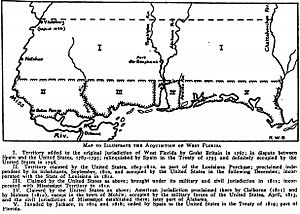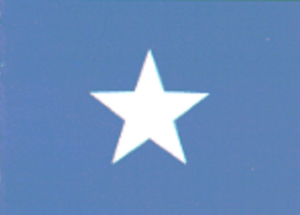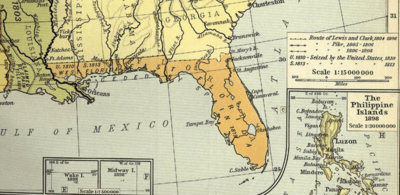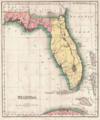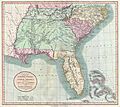West Florida facts for kids
Quick facts for kids West Florida |
|||||||||||||||||
|---|---|---|---|---|---|---|---|---|---|---|---|---|---|---|---|---|---|
| Territory of Great Britain (1763–1783), Spain (1783–1821). Areas disputed between Spain and United States from 1783–1795 and 1803–1821. | |||||||||||||||||
| 1763–1821 | |||||||||||||||||
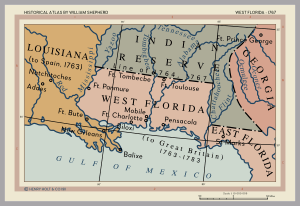 British West Florida in 1767 |
|||||||||||||||||
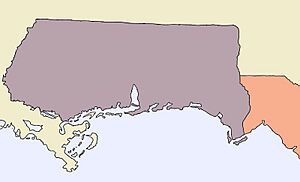 Digital map of West Florida in 1767 |
|||||||||||||||||
| Capital | Pensacola | ||||||||||||||||
| Government | |||||||||||||||||
| Governor | |||||||||||||||||
|
• 1763–1783
|
5 under Britain | ||||||||||||||||
|
• 1783–1821
|
10 under Spain | ||||||||||||||||
| History | |||||||||||||||||
| 10 February 1763 | |||||||||||||||||
| November 25, 1783 | |||||||||||||||||
| 1795 | |||||||||||||||||
| 1800 | |||||||||||||||||
| 1810 | |||||||||||||||||
|
• Annexation by U.S.
|
1810 | ||||||||||||||||
| 22 February 1821 | |||||||||||||||||
|
|||||||||||||||||
West Florida (in Spanish, Florida Occidental) was a region along the northern coast of the Gulf of Mexico. Its borders and who controlled it changed many times throughout history. It was created from the western part of what was once Spanish Florida. The Apalachicola River separated it from East Florida.
West Florida also included land taken from French Louisiana. Pensacola became its capital city. This area covered about two-thirds of today's Florida Panhandle. It also included parts of modern-day Louisiana, Mississippi, and Alabama.
Great Britain created West and East Florida in 1763. They got this land from France and Spain after the Seven Years' War. The new territory was too big to manage from one place. So, the British split it into two colonies.
British West Florida included the part of Spanish Florida west of the Apalachicola River. It also had parts of French Louisiana. Its government was in Pensacola. West Florida stretched from the Mississippi River to the Apalachicola River. Its northern border changed several times.
Both West and East Florida stayed loyal to Britain during the American Revolution. They were safe places for Loyalists fleeing the Thirteen Colonies. Spain invaded West Florida and captured Pensacola in 1781. After the war, Britain gave both Floridas back to Spain.
However, the unclear borders led to arguments. These were called the West Florida Controversy. They were between Spanish West Florida and the new United States.
Because of problems with the Spanish government, American and English settlers declared their area independent. This was the Republic of West Florida in 1810. This short-lived republic was not in modern Florida. Instead, it was in the Florida parishes of today's Louisiana.
Within months, the United States took control. The U.S. claimed the region as part of the Louisiana Purchase of 1803. In 1819, the U.S. bought the rest of West Florida and all of East Florida. This was done through the Adams–Onís Treaty. In 1822, both were combined into the Florida Territory.
Contents
How West Florida Began
The area known as West Florida was first claimed by Spain. It was part of La Florida. This large area included most of what is now the southeastern United States. Spain tried to settle the area many times. One attempt was by Tristán de Luna y Arellano in 1559. But permanent settlements did not start until the 1600s. This was with missions to the Apalachee people. In 1698, the settlement of Pensacola was built. Its purpose was to stop French expansion.
In the late 1600s, the French started their own settlements. These were part of colonial Louisiana. Important French towns included Mobile (1702) and Fort Toulouse (1717). These are in present-day Alabama. After many disagreements, the Perdido River became the border. This river is now the border between Florida and Alabama. It separated French Louisiana and Spanish Florida.
Before 1762, France owned the land west of the Perdido River. This was part of La Louisiane. In 1762, a secret treaty gave Spain all French Louisiana west of the Mississippi River. This also included the Isle of Orleans. Spain did not fully take control of Louisiana until 1769. So, for six years, the land between the Mississippi and Perdido rivers was not part of Louisiana. This land went directly from France to Britain in 1763.
In 1763, the treaty ending the French and Indian War (also called the Seven Years' War) was signed. Britain gained all French Louisiana east of the Mississippi River. This included the land between the Perdido and Mississippi Rivers. Spain also gave its territory of La Florida to Great Britain. In return, Spain got Cuba, which the British had captured during the war.
Because of this, for the next 20 years, the British controlled most of the Gulf of Mexico coast. This was east of the Mississippi River. Most Spanish people left Florida at this time. Their government records moved to Havana, Cuba.
Colonial Rule in West Florida
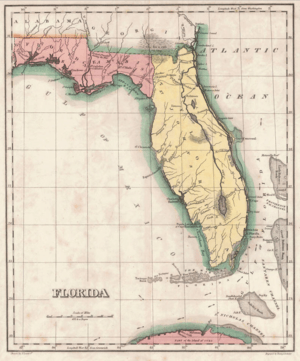
British Control (1763-1783)
The British found their new territory too large to manage as one area. So, they divided it into two new colonies: West Florida and East Florida. The Apalachicola River separated them. This was set out in the Royal Proclamation of 1763. East Florida included most of the former Spanish Florida. Its capital remained St. Augustine.
West Florida covered the land between the Mississippi and Apalachicola Rivers. Pensacola was chosen as its capital. The northern border was set at the 31st parallel north. Many English Americans and Scotch-Irish Americans moved to this area.
In November 1763, George Johnstone became Governor of West Florida. His lieutenant governor, Montfort Browne, owned a lot of land and helped the province grow. Seven General Assemblies, like small parliaments, met between 1766 and 1778.
In 1764, the British moved the northern border further north. It went up to 32° 22′ north latitude. This extended from the Yazoo River to the Chattahoochee River. This new area included the Natchez District and the Tombigbee District. It covered roughly the southern halves of today's Mississippi and Alabama. Many new settlers arrived with the British soldiers, increasing the population.
In 1774, the First Continental Congress invited West Florida to send delegates. But the people of West Florida were mostly Loyalist, so they refused. During the American War of Independence, Peter Chester was Governor of West Florida. John Campbell was the commander of British forces. The colony was attacked in 1778 by the Willing Expedition.
Spanish Control (1783-1810)
Spain joined the American Revolutionary War on the side of France. However, they did not join with the Thirteen Colonies. Bernardo de Gálvez, the governor of Spanish Louisiana, led a military campaign. He captured Baton Rouge and Natchez from the British in 1779. He also took Mobile in 1780 and Pensacola in 1781.
In the 1783 Treaty of Paris, which ended the war, Britain agreed on a border. This border was between the United States and West Florida. It was at 31° north latitude, between the Mississippi and Apalachicola Rivers. But a separate agreement between Britain and Spain gave both Florida provinces back to Spain. This agreement did not state a northern border for Florida. The Spanish government thought the border was the same as in the 1763 agreement. This led to the first West Florida Controversy.
Spain claimed the expanded 1764 border. The United States claimed the border was at the 31° parallel. Talks in 1785–1786 between John Jay and Don Diego de Gardoqui did not solve the problem. The border was finally settled in 1795 by the Treaty of San Lorenzo. In this treaty, Spain recognized the 31° parallel as the boundary.
Spain continued to keep East and West Florida as separate colonies. When Spain got West Florida in 1783, the eastern British border was the Apalachicola River. But in 1785, Spain moved it eastward to the Suwannee River. This was to move San Marcos and the Apalachee district from East Florida to West Florida.
In a secret agreement called the Third Treaty of San Ildefonso in 1800, Spain agreed to give Louisiana back to France. However, the exact borders were not clearly stated. After France sold the Louisiana Purchase to the United States in 1803, another border dispute started. The United States claimed the territory from the Perdido River to the Mississippi River. Americans believed this had been part of the old province of Louisiana. They thought it was part of what the French had agreed to give to Spain in 1762.
The Spanish argued that they had managed that part as the province of West Florida. They said it was not part of the territory returned to France in 1802. This was because France had never given West Florida to Spain. There were many other reasons for their claim.
The Republic of West Florida
The United States and Spain had long, unsuccessful talks about West Florida. Meanwhile, American settlers moved into the area. They did not want to be under Spanish control. British settlers who had stayed also disliked Spanish rule. This led to a rebellion in 1810. For 74 days, the Republic of West Florida was an independent country.
From June to September 1810, many secret meetings took place. These were in the Baton Rouge area. People who disliked Spanish rule attended. Three open meetings also happened. These meetings led to the West Florida rebellion. The independent Republic of West Florida was formed. Its capital was St. Francisville, in present-day Louisiana. It was on a high bank along the Mississippi River.
Early on September 23, 1810, armed rebels attacked Fort San Carlos at Baton Rouge. They killed two Spanish soldiers in a fierce fight. This gave them control of the region from the Spanish. The rebels raised the flag of their new republic. It was a single white star on a blue background. After this successful attack, led by Philemon Thomas, they planned to take Mobile and Pensacola from the Spanish. They wanted to add the eastern part of the province to their new republic. Reuben Kemper led a small group to try and capture Mobile, but they failed.
Not everyone supported the revolt. There were groups who supported Spain, groups who supported the U.S., and groups who wanted independence. Many foreign agents were also present. This led to a "virtual civil war" within the revolt. The different groups fought for power. The group that wanted West Florida to stay independent created a constitution in October. This group had earlier asked General Philemon Thomas to lead an army. His job was to march across the territory, stop opposition, and take as much Spanish land as possible. People in the western Florida Parishes mostly supported the revolt. But most people in the eastern Florida Parishes were against it. Thomas's army used force against those who opposed the revolt. This left a difficult legacy in the Tangipahoa and Tchefuncte River areas.
On November 7, Fulwar Skipwith was elected governor. Members of a two-house legislature were also chosen. Skipwith was officially sworn in on November 29. A week later, he and many officials were still in St. Francisville. They were getting ready to go to Baton Rouge. The next legislative meeting was to discuss his plans. The upcoming U.S. takeover seemed to surprise Skipwith. The Mississippi Territory governor, David Holmes, and his group approached the town. Holmes convinced almost everyone, except a few leaders like Skipwith and Philemon Thomas, to accept American authority.
Skipwith complained to Holmes. He said that because the U.S. had allowed Spanish control for seven years, the U.S. had given up its right to the country. He also said the West Florida people would not join the American government without conditions. Skipwith and some of his lawmakers then went to the fort at Baton Rouge. They did not want to surrender the country without terms.
At Baton Rouge on December 9, Skipwith told Holmes he would no longer resist. But he said he could not speak for the soldiers in the fort. Their commander was John Ballinger. Holmes promised his soldiers would not be harmed. Ballinger then agreed to surrender the fort. The Orleans Territory governor, William C. C. Claiborne, and his armed forces from Fort Adams landed two miles from the town. Holmes told Claiborne that "the armed citizens ... are ready to retire from the fort and acknowledge the authority of the United States" without asking for any terms. Claiborne agreed to a respectful ceremony for the transfer. So, at 2:30 p.m. that day, December 10, 1810, "the men within the fort marched out and stacked their arms and saluted the flag of West Florida as it was lowered for the last time, and then dispersed."
The Republic of West Florida's borders included all land south of 31°N parallel. It was east of the Mississippi River. It was north of the waterway formed by the Iberville River, Amite River, Lake Maurepas, Pass Manchac, Lake Pontchartrain and The Rigolets. The Pearl River and its branch flowing into The Rigolets formed the eastern border of the republic.
The United States Takes Over
On October 27, 1810, U.S. President James Madison announced that the United States would take West Florida. This was the area between the Mississippi and Perdido Rivers. He based this on a weak claim that it was part of the Louisiana Purchase. The West Florida government did not want to be taken over. They preferred to negotiate terms to join the U.S. Governor Fulwar Skipwith declared that he and his men would "surround the Flag-Staff and die in its defense."
William C. C. Claiborne was sent to take control of the territory. He entered the capital of St. Francisville with his forces on December 6, 1810. He entered Baton Rouge on December 10, 1810. Claiborne refused to accept the West Florida government as real. Skipwith and the legislature eventually agreed to Madison's announcement. Congress passed a resolution on January 15, 1811. It allowed for temporary control of the disputed territory. It also stated that the territory would be subject to future talks.
On February 12, 1812, Congress secretly allowed President James Madison to take the part of West Florida west of the Perdido River. This was the part not already controlled by the U.S. He was allowed to use military force if needed. The part of the territory west of the Pearl River became part of the new Territory of Orleans on April 14, 1812. The U.S. added the Mobile District of West Florida to the Mississippi Territory on May 14, 1812. But this was not done with military force until almost a year later. (See Major Gen. James Wilkinson's role). One historian said that taking West Florida into the Orleans district showed "infant American imperialism." Claiborne and his army, with Madison's order, forced Skipwith and his supporters to accept foreign rule.
The U.S. Claim to West Florida
In a secret treaty on October 1, 1800, between France and Spain, called the St. Ildefonso treaty, Spain gave Louisiana back to France in 1802. This was Louisiana as Spain had it then, and as France last had it in 1769. (President Madison's 1810 proclamation referred to France's original possession, not its last.)
When Louisiana was transferred to the United States, the same words from Article 3 of the 1800 St. Ildefonso treaty were used. This unclear wording helped U.S. envoy James Monroe. But he had to use an interpretation that France had not claimed and Spain had not allowed. Monroe looked at each part of the third article. He interpreted the first part as if Spain had seen West Florida as part of Louisiana since 1783. The second part just made the first part clearer. The third part referred to the treaties of 1783 and 1795. It was meant to protect the rights of the United States. This part simply made the others work.
Monroe believed France never broke up Louisiana when it owned it. (He thought November 3, 1762, was when France stopped owning it, not 1769, when France formally gave Louisiana to Spain). After 1783, Spain reunited West Florida to Louisiana, Monroe said. This completed the province as France had it, except for parts controlled by the United States. So, by a strict reading of the treaty, Spain might have to give the U.S. any land west of the Perdido that once belonged to France.
Arguments Against the U.S. Claim
- As part of the 1803 Louisiana Purchase treaty, France repeated Article 3 of its 1800 treaty with Spain word for word. This meant the United States took over the rights of France and Spain.
- In 1800, the area called Louisiana did not include West Florida.
- Spain always refused to give any part of Florida to France in all talks.
- In 1801, Spain told its governors in North America that the land given to France did not include West Florida.
- In Spanish government rules and treaties, the Floridas were always listed as separate from other Spanish lands.
- France's 1801 Treaty of Aranjuez with Spain said the giving of Louisiana was a "restoration," not a return.
- France never gave any part of Florida to Spain, so Spain could not give it back.
- When Spain held the Floridas, they were always called the Floridas. They were never called part of Louisiana. Treaties between the United States and Spain also called them the Floridas.
- In 1803, France started talking with Spain to get West and East Florida. This showed France did not think it already owned West Florida.
- During his talks with France, U.S. envoy Robert Livingston wrote nine reports to Madison. He said West Florida was not owned by France.
- President Jefferson asked U.S. officials in the border area for advice on Louisiana's limits. The best informed officials did not believe it included West Florida.
- When Louisiana was formally given to the United States, the U.S. did not demand West Florida.
- In the summer of 1804, the United States and Spain asked France to help interpret the treaty. Napoleon strongly supported Spain.
- In November 1804, France told Livingston that the American claim to West Florida was completely wrong.
- In January 1805, the French and Spanish ambassadors together told Madison that the American claim to West Florida was not valid. Madison pointed to maps from before 1763 that showed West Florida as part of old French Louisiana. The French ambassador pointed out that the same applied to Tennessee and Kentucky, which surprised Madison.
- After Monroe's special mission in 1804–1805 failed, Madison was ready to give up the American claim to West Florida entirely.
- In 1805, Monroe's last offer to Spain to get West Florida was completely rejected.
- In an 1809 letter, Jefferson almost admitted that West Florida was not U.S. property.
- The U.S. claim to Louisiana itself was flawed because of the 1800 France-Spain treaty.
- General Andrew Jackson personally accepted the title to West Florida from its Spanish governor on July 17, 1821.
Later History and What Remains Today
Spain continued to argue about the U.S. taking over the western parts of its West Florida colony. But Spain's power in the region was too weak to do anything. They kept managing the rest of the colony (between the Perdido and Suwannee Rivers) from Pensacola.
On February 22, 1819, Spain and the United States signed the Adams-Onís Treaty. In this treaty, Spain gave both West and East Florida to the United States. In return, the U.S. paid money and gave up its claims to Texas. After Spain approved it on October 24, 1820, and the United States on February 19, 1821, the treaty became active. This set the current borders.
President James Monroe was allowed on March 3, 1821, to take control of East Florida and West Florida for the United States. He also had to set up the first government. So, the U.S. military took over and governed both Floridas. Andrew Jackson served as governor. The United States soon organized the Florida Territory on March 30, 1822. They combined East Florida and the remaining West Florida (east of the Perdido River). They set up a territorial government. Florida became a state on March 3, 1845.
West Florida influenced where Florida's current capital is located. At first, the Florida Territorial Legislative Council decided to switch between the old capitals of Pensacola and St. Augustine. The first meeting was in Pensacola on July 22, 1822. Delegates from St. Augustine had to travel 59 days by sea to attend. To get to the second meeting in St. Augustine, Pensacola members traveled 28 days over land. During this meeting, the council decided future meetings should be held halfway. This would reduce travel distance. Eventually, Tallahassee was chosen. It was the site of an Apalachee settlement in the early 1700s. It was a halfway point between the former capitals of East and West Florida.
The parts of West Florida that are now in Louisiana are called the Florida Parishes. The Republic of West Florida Historical Museum is in Jackson, Louisiana. It is run by the Republic of West Florida Historical Association. In 1991, a lineage society was founded. It is called The Sons & Daughters of the Province & Republic of West Florida 1763–1810. Its goal is to "collect and preserve records, documents and relics pertaining to the history and genealogy of West Florida prior to December 7, 1810." In 1993, the Louisiana State Legislature renamed Interstate 12. This highway, which is entirely in the Florida Parishes, became the "Republic of West Florida Parkway." In 2002, Leila Lee Roberts, a great-granddaughter of Fulwar Skipwith, gave the original copy of the West Florida Republic's constitution and related papers to the Louisiana State Archives.
Images for kids
-
Annotated map of the territorial changes of British and Spanish West Florida
-
Under Spanish rule, Florida was divided by the natural separation of the Suwannee River into West Florida and East Florida. (map: Carey & Lea, 1822)
-
1806 John Cary map shows West Florida (including Pensacola, which was not part of the U.S. claim) in the hands of Spain, separate from the U.S.-held Louisiana Purchase.
See also
 In Spanish: Florida Occidental para niños
In Spanish: Florida Occidental para niños




